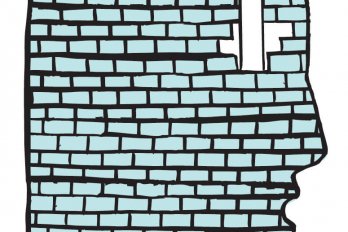
Göbekli tepe — At a small archaeological site about twenty kilometres outside Sanliurfa, in southeastern Turkey, Klaus Schmidt climbs to the top of a hill, moving quickly despite the stifling heat. Schmidt is the fifty-three-year-old director of the dig. His face is red from the sun, and his only protection from its rays is a white cotton scarf wrapped around his head, kaffiyeh style. Atop the windswept hill, bare except for a solitary mulberry tree, he looks down on what may be the most remarkable archaeological find of the past century.
“The level of importance here is that of the pyramids in Giza, or Stonehenge,” says Schmidt, who speaks softly, with a strong German accent. “This is the first monumental work in the history of mankind. It’s a singular site.” Schmidt got an early start in archaeology, mucking around as a child in the caves of his native Bavaria in a fruitless search for drawings left by cavemen. His luck changed fourteen years ago when he first came to Göbekli Tepe (Turkish for “navel on the mountain”).
From where he stands, he can see four circles of large, T-shaped stone pillars arranged around two even larger monoliths — some five metres tall — that tower over the circles. Many of the forty-odd pillars are decorated with exquisite relief carvings depicting a lush landscape populated by wild boars, birds, reptiles, and lions. The level of representation becomes even more breathtaking in the context of the site’s age; the various layers were created somewhere between 7500 and 10,000 BC, according to carbon dating done by Schmidt. That’s before the invention of the wheel.
To put this finding in perspective, until the discovery of Göbekli Tepe, arguably the oldest temple excavated was at Eridu, in Iraq, which dates to 5000 BC. Stonehenge’s rough pillars, which look like the work of rank amateurs compared to the handiwork here, only go back to approximately 2100 BC.
It may sound as if Schmidt has been standing out in the blazing sun too long, but he’s no fringe archaeologist. He’s a veteran of another groundbreaking dig in Turkey and a respected member of the august German Archaeological Institute in Berlin. He and Göbekli Tepe have already created a serious buzz among other archaeologists who study the early neolithic period, when hunter-gatherers in the Near East started the process of cultivating cereals and producing their own food. “It’s a very important site, a central ritual site, like the temple in Jerusalem or the Oracle at Delphi,” says Ofer Bar-Yosef, MacCurdy Professor of Prehistoric Archaeology at Harvard, who has visited Schmidt’s dig. “It has changed for many people the conception of what was happening during the neolithic period.
“The findings at Göbekli Tepe have given Schmidt and his colleagues a profoundly new understanding of this part of the world at that time. The local culture, he now believes, was much more developed and organized than previously thought. The builders of Göbekli Tepe could already muster — and feed — the enormous manpower needed to carve the massive columns and bring them to the temple site.
Even more surprising, Schmidt says, is the sophistication of religious expression found at Göbekli Tepe. Because of the lack of settlements nearby, Schmidt and others believe the site was a destination for pilgrims and a place of ritual. “What we have here is an expression of religion in a very stylized way that is not repeated anywhere else in the world,” he says. “We see that religion was existing in the early neolithic period in a way that we didn’t expect. Only religion could be responsible for what we see here.
“Something else is adding to the buzz around Göbekli Tepe — speculation that may tie the spot to the Bible’s Garden of Eden story. Some respected researchers, such as archaeologist Alan Millard and biologist Colin Tudge, both based in England, have put forward the theory that the Eden story was born of a collective memory of, as Schmidt puts it, “the transition from hunting-gathering to working the land, from being free individuals to working in the fields.”
From Göbekli Tepe, the flat and arid Mesopotamian plain stretches south toward the nearby Syrian border, a thin haze floating above it. Around the site, the landscape is treeless and rocky. But it wasn’t always like this, Schmidt says. When hunter-gatherers lived here, he explains, fruit trees and wild grasses grew in abundance, and there were more than enough animals to hunt. With its carvings celebrating the abundance of the surrounding countryside and the freedom of hunting life, was Göbekli Tepe actually a memorial to what was slowly becoming a paradise lost?
Schmidt is reticent about linking his work to the Adam and Eve story, worried it will be lumped together with such quasi-Biblical archaeological pursuits as the search for Noah’s ark and, well, the Garden of Eden. Various theories have situated paradise on at least three continents. But Sanliurfa, the closest city to the dig, has no qualms about making the connection. City hall is already happily promoting Göbekli Tepe as the birthplace of civilization — and home to Adam and Eve.





